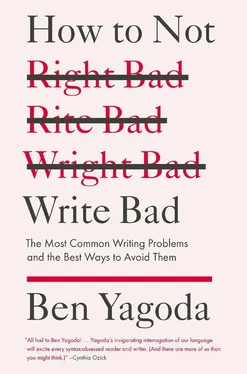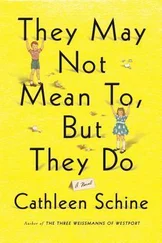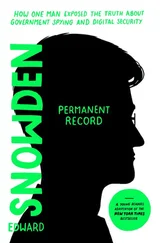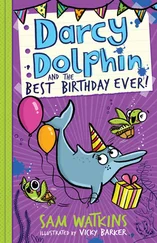[ The boy is seven-years-old, the ideas are out-of-date, and I am fed-up. ]
The boy is seven years old, the ideas are out of date, and I am fed up.
Finally, please note that it’s never correct to put space before a hyphen (except in very rare cases, like a reference to “the suffix —less ”) It’s correct to put space after a hyphen in only one situation, of which this is an example:
This year Rollins had 17- and 28-game hitting streaks.
3. —
A dash — sometimes known as an “em-dash”—is created when you type two hyphens in a row. (Your word processing program, as if by magic, will make them into one solid line.) Do not put a space before or after the dash.
[ I hate one day of the week- Monday. ]
[ I hate one day of the week — Monday. ]
[ I hate one day of the week — Monday. ]
I hate one day of the week — Monday.
Don’t put any other punctuation before or after a dash, even if doing so seems to make sense. This was customary in the nineteenth century and before. It is not now.
[ The vice president asked for a pay raise — his first in seven years—, never thinking the media would hear about it. ]
The vice president asked for a pay raise — his first in seven years — never thinking the media would hear about it.
Finally, limit your dashes. The maximum is one per sentence (if you’re using it as a colon substitute) or two (if you’re using them in place of parentheses.). Beyond that lies confusion.
[ He accumulated one college degree — from Michigan State — and two PhDs — from Harvard and NYU — before his thirtieth birthday. ]
He accumulated one college degree (from Michigan State) and two PhDs (from Harvard and NYU) before his thirtieth birthday.
4.,
a. Identification Crisis
Commas yield the most errors of any category of punctuation, and their use in identification yields the highest percentage of comma errors. When a poor or mindless writer is at the keyboard, you can be pretty certain he or she will get this wrong. Getting it right is a matter of studying the rules, some mindful focus, and practicing hearing-with-your-mind’s-ear writing. Anyway, if you can master this entry, you will have taken several big and important steps in the right direction.
Take a look at this sentence:
[ I went to see the movie, True Grit with my friend, Bill. ]
It’s very common to put a comma after movie and friend —and sometimes after Grit —in examples such as this. But doing so is wrong — unless True Grit is the only movie in the world and Bill is the speaker’s only friend.
The first is definitely not the case, and you can be fairly confident the second isn’t, either. Therefore, the correct form is:
I went to see the movie True Grit with my friend Bill.
If that seems funky or weird or anything short of clearly right, bear with me a minute and take a look at another correct sentence.
I went to see the Coen brothers’ latest movie, True Grit, with my oldest friend, Bill.
You need a comma after movie because True Grit and only True Grit is the brothers’ latest film, and after Bill because he and only he is the speaker’s oldest friend. (For why you need one after Grit , see the next entry.)
The structure we’re talking about is identifier-noun. The general rule is that if the noun is not the only thing in the world described by the identifier, leave out the comma. But if the identifier describes that noun and that noun alone, the comma is required.
There is one exception. If the identifier is preceded by a, an , a number, or a quantifying phrase like a couple of , use a comma before and after the noun.
A local merchant, Bob Hamilton, has opened his second Taco Bell.
Two members of the Hall of Fame, Johnny Bench and Willie Mays, will give speeches at the event.
With the or a possessive before the identifier, the basic rule applies. That is, use a comma if the identifier describes a unique person or thing:
The president of the Springfield Bar Association, Harold Cullen, was reelected unanimously.
My son, John, is awesome. (If you have just one son.)
But withhold the comma if not unique:
My son John is awesome. (If you have more than one son.)
The artist David Hockney is a master of color.
[ I love the cellist, Yo-Yo Ma. ]
If nothing comes before the identification, don’t use a comma; the word the is implied.
[ The keynote speech was given by attorney, Harold Cullen. ]
The keynote speech was given by attorney Harold Cullen.
No one seems to have a problem with the idea that if the identification comes after the noun, it should always be surrounded by commas:
Harold Meyerson, a local merchant, gave the keynote address.
However, students often wrongly omit a the or a in sentences of this type:
[ Jill Meyers, sophomore, is president of the sorority. ]
Jill Meyers, a sophomore, is president of the sorority.

[ The U.S. was represented by Hillary Clinton, secretary of state. ]
The U.S. was represented by Hillary Clinton, the secretary of state.
Sometimes the identifier consists of the, a, or a possessive followed by two or more adjectives. In some cases, a comma goes between the adjectives, and in some cases not.
a. [ In my safe I have a valuable, wooden nickel. ]
b. In my safe I have a valuable wooden nickel.
a. [ The best fruit of all is a ripe juicy flavorful peach. ]
b. The best fruit of all is a ripe, juicy, flavorful peach.
Why is a wrong and b right, and how can you decide whether to use commas in these situations? The rule I learned in junior high school still holds. Anytime you can insert the word and between adjectives and it still sounds fine, use a comma. If not, don’t.
b. The Case(s) of the Missing Comma
i. A related issue is the epidemic of missing commas after parenthetical phrases or appositives — that is, self-enclosed material that’s within a sentence, but not essential to its meaning.
[ My father, who gave new meaning to the expression hardworking never took a vacation. ]
My father, who gave new meaning to the expression hardworking, never took a vacation.

[ He was born in Des Moines, Iowa in 1964. ]
He was born in Des Moines, Iowa, in 1964.

[ Philip Roth, author of Portnoy’s Complaint and many other books is a perennial contender for the Nobel Prize. ]
Philip Roth, author of Portnoy’s Complaint and many other books, is a perennial contender for the Nobel Prize.
I’m not sure why this mistake is so tempting. It may sometimes be because these phrases are so long that by the time we get to the end of them, we’ve forgotten about the first comma. In any case, a strategy to prevent it is to remember the acronym ICE. That is, whenever you find yourself using a comma to precede an Identification, Characterization , or Explanation , remember that the ICE has to be followed by a second comma. (The exception is when the ICE ends the sentence, in which case it’s followed by a period.)
Читать дальше













